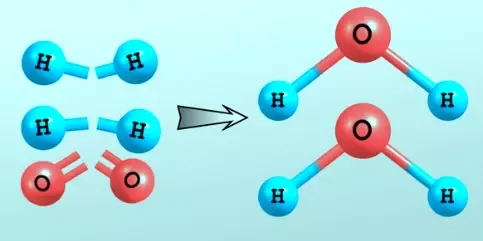
Factors affecting the rate of chemical reactions

A chemical reaction is represented by writing a chemical equation.
- A chemical reaction is a process in which some substances undergo bond breaking and transfer into new substances by the formation of new bonds.
- The substance's breaking part in a chemical reaction is called reactants, whereas the substances formed as a result of a chemical reaction by the formation of new bonds are called products. For example,
C + O2 ------------> CO2
combustion
Therefore, it is easy to represent any chemical reaction by writing a chemical equation.State the various type of chemical reactions.
Chemical reactions are classified into four types by nature and the number of the reactants and the products.
- Combination reaction:
When two or more reactants combine in a reaction to form a single product is called a combination reaction.
NH3(g) + HCL (g)----------> NH4 Cl(s)
ammonia + Hydrochloride ----> ammonium chloride
2Mg + O2 ------->2MgO
Ca O + H2O----------> Ca(OH)2 + Heat
calcium oxide + Water ---------> calcium hydroxide
- Decomposition reaction:
The chemical reaction in which two or more products are formed from a single reactant is called a Decomposition Reaction.
C12 + H22 + O11-----------> 12 C + 11 H2O
CaCO3 ----------> CaO + CO2
2H2 O2 ---------->2H2O + O2
- Displacement reaction:
The reaction in which the place of the ion of a less reactive element in a compound is taken by another more reactive element by the formation of its own ions is called displacement reaction.
CuSO4 + Fe --------->FeSO4 + Cu
CuSO4 + Pb ---------> PbSO4 + Cu.
- Double displacement reaction:
The reaction in which the ions in the reactants are exchanged to form a precipitate is called a double displacement reaction.
K2CrO2 + BaSO4 ---------->BaCrO2 + K2SO4
Write a notice on the endothermic and exothermic reactions.
Considering processes and reactions, it is classified as endothermic and exothermic reactions.
- Exothermic Reaction:
Heat is given away during a chemical reaction when reactants are transformed into products. e.i. formation of ice.
CaO + H2O ---------> Ca(OH)2 + Heat
- Endothermic reaction:
Heat is either absorbed from the surroundings or has to be supplied continuously from outside during endothermic chemical reactions. e. i. melting of ice.
CaCO3 + heat ---------> CaO + CO2
What are the factors affecting the rate of a chemical reaction?
The rate of different reactions is different. Give reason.
Some reactions are completed in a short time, which is occurring rapidly. While some others require a long time for completion and those reactions occurs at a different rate on changing the condition and the factors which decide the rate of chemical reactions are following:
- Nature of reaction:
The nature of metal is responsible and the nature of reactivity of reactants influences the rate of a chemical reaction.
- Size of the particles of reactants:
The rate of a reaction depends upon the size of the particles of the reactants taking part in the reaction. The smaller the size of the reactant's particles, the higher is the rate of the reaction.
- The concentration of the reactants:
Concentrated acid reacts faster than dilute acid. This means that the rate of reaction is proportional to the concentration of reactants.
- The temperature of the reaction:
The rate of a reaction increases by increasing the temperature.
- Catalyst:
The substance in whose presence the rate of chemical reaction changes, without causing any chemical change to it, is called a catalyst.
2KClO3 ----------->2KCl + 3O2
MnO2
No chemical change takes place in mno2 in this reaction.
Write short notes on oxidation reaction.
The chemical reaction in which the reactants combine with oxygen or loss is hydrogen to form the product is called an oxidation reaction.
2Mg + O2--------> 2MgO
C + O2 ---------> CO2
MgH2 ----------> Mg + H2
CH3-CH3----------> CH2=CH2
(O)
CH3-CH2-OH --------------------> CH3 - COOH
Ethyl Alcohol K2Cr2O/H2SO4 Acetic Acid
Here the acidic potassium Dichromate makes oxygen available for the oxidation of the reactant ethyl alcohol, such chemical substances which bring about an oxidation reaction by making oxygen available are called oxidants or oxidizing agents. When the positive charge on an atom or an ion increases the negative charge on these decreases is called oxidation.
Write a short note on reduction reaction.
The chemical reaction in which reactants gain hydrogen or losses oxygen to form the product is called a reduction reaction.
CuO + H2 ---------> Cu + H2O
When the positive charge decreases, the negative charge increases it is called a reduction reaction.
Write short notes on redox reactions.
The reactant is oxidized by the oxidant and the oxidant is reduced by the reductant by this characteristic of the reduction and oxidation reaction is called a redox reaction.
redox reaction = reduction + oxidation.
Write short notes on corrosion.
The rust is formed by an electrochemical reaction. Different regions on the surface of iron became anode and cathode.
- Fe is oxidized to (Fe^2+) in the anode region.
Fe----->( Fe^2+) + 2e
- O2 is reduced to form water in the cathode region.
O2 + 4H2O--------> Fe2O3 . H2O + 6H^+
Rancidity:
When we use old, leftover cooking oil for making foodstuff, it is found to have foul adour called Rancidity.
If you have any questions regarding this article, then you write them in the comment section. For further study, you click here.

